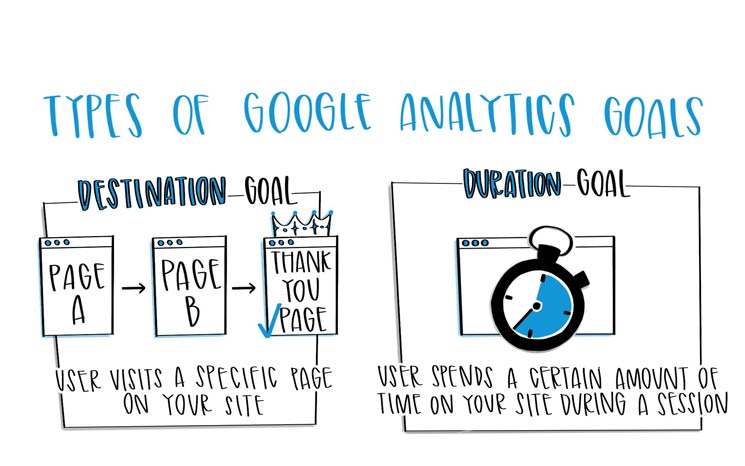Revealing the Blind Attractions: Understanding What Google Analytics Goals Can not Determine
In the world of electronic analytics, Google Analytics stands as an effective device for tracking and evaluating on the internet individual communications. Amidst its robust capabilities, there exist blind places that often escape dimension. what data is google analytics goals unable to track. Recognizing what Google Analytics goals can not determine is essential for getting an extensive view of user actions and involvement. As we dig right into the ins and outs of these unseen areas, we uncover a complicated internet of uncharted areas that hold beneficial understandings right into customer actions and motivations, challenging standard wisdom and dropping light on the limitations of our data-driven understanding.
Customer Actions on External Platforms
Recognizing exactly how users engage on external platforms is critical for enhancing on-line techniques. External platforms, such as social media networks, referral sites, and on-line forums, play a substantial role in driving web traffic to a firm's web site. By examining customer behavior on these platforms, organizations can gain useful insights into the efficiency of their marketing efforts and the choices of their target audience.
One trick facet of user habits on exterior systems is the recommendation resource. By tracking where the users are coming from, services can recognize which platforms are driving the most traffic to their web site. This details can help companies assign their sources better, concentrating on the platforms that produce the ideal outcomes.

Offline Communications and conversions
Evaluating user actions on outside systems gives important understandings right into online methods; however, considering offline conversions and communications is equally essential for a thorough understanding of a business's total performance. Offline conversions, such as in-store purchases or phone inquiries, play a substantial role in lots of businesses' success.

Attribution Beyond Last Click
When delving into the world of electronic marketing analytics, it ends up being necessary to look beyond the single touchpoint of the last click for a more detailed understanding of acknowledgment. While Google Analytics gives important insights into individual habits, depending only on last-click attribution can be limiting - what data is google analytics goals unable to track. Attribution designs that exceed the last click supply an extra nuanced sight of the consumer journey, taking into consideration all the touchpoints that result in a conversion
Attribution past the last click permits marketers to assign credit score to numerous interactions along the conversion path, offering a clearer image of the performance of various advertising and marketing networks. By checking out multi-touch attribution versions such as direct, time decay, or position-based attribution, businesses can much better designate their advertising budgets and maximize their methods for maximum influence.
Recognizing the influence of each touchpoint in the conversion procedure is critical for making notified decisions and making best use of ROI. By accepting attribution past the last click, companies can gain much deeper insights right into customer actions and customize their advertising and marketing efforts extra successfully.
Cross-Device and Cross-Browser Tracking

Likewise, cross-browser monitoring enhances cross-device monitoring by recording customer great site habits as they change in between different web internet browsers. Understanding exactly how individuals communicate with sites on various internet browsers can help marketing experts maximize their online experiences to make sure uniformity and capability across various platforms.
Qualitative Information and Customer Intent
Comprehending individual intent through qualitative information analysis is vital for establishing targeted digital advertising techniques that reverberate with the needs and choices of the target audience. Qualitative information offers insights right into the 'why' behind individual actions, clarifying motivations, emotions, and preferences that quantitative information alone can not catch. By examining user comments, remarks, and communications, online marketers can uncover important details about user intent, permitting them to customize their messaging, material, and offerings to read the full info here much better straighten with what their target market is seeking.
Qualitative data also helps in recognizing the context in which individuals involve with a web site or application. This contextual understanding allows marketing professionals to create even more individualized and pertinent experiences, inevitably driving higher involvement and conversion rates. By delving right into individual intent with qualitative information evaluation, services can obtain a much deeper understanding of their target market, leading to extra effective advertising approaches that fulfill customers' demands and expectations.
Conclusion
In verdict, Google Analytics objectives have restrictions in measuring individual actions on outside systems, offline conversions, attribution past last click, cross-device and cross-browser monitoring, and qualitative data associated with customer intent. what data is google analytics goals unable to track. It is vital for services to be conscious of these unseen areas in order to supplement their data evaluation with other devices and methods to obtain a much more extensive understanding of their audience and improve their total electronic advertising techniques
By analyzing customer habits on these platforms, companies can acquire important understandings into the efficiency of their advertising efforts and the choices of their target audience.
Examining user habits on external platforms provides useful insights into on the internet methods; however, considering offline conversions and communications is just as necessary for find more information a thorough understanding of a business's overall performance.In electronic advertising analytics, moving past last-click attribution to explore cross-device and cross-browser tracking is vital for gaining a holistic understanding of individual communications across numerous systems and gadgets. By evaluating customer feedback, comments, and communications, marketers can reveal useful information concerning individual intent, permitting them to tailor their messaging, content, and offerings to better line up with what their target market is looking for.
By diving into user intent via qualitative information analysis, companies can obtain a much deeper understanding of their target audience, leading to a lot more efficient marketing approaches that meet users' expectations and needs.